AS350 D-HEWU HESLO Fuel Incident (Superabsorbent Polymer Contamination)
On 16 July 2024, Airbus AS350B2 D-HEWU, operated by Heli Transair, made a forced landing in Wiesenbach, Bavaria, while engaged in Helicopter External Sling Load Operations (HESLO).
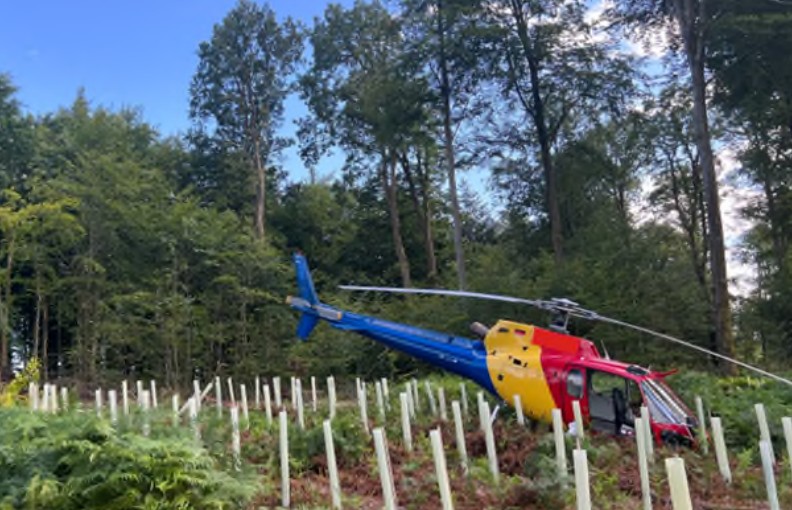
Heli Transair Airbus AS350B2 D-HEWU After Forced Landing During HESLO (Credit: via BFU)
The German safety investigation body, the BFU, released their safety investigation report on 14 May 2025.
The Day’s Operations
The HESLO task for the day was forest liming, operated under a Part-SPO declaration for specialised operations. This involved a 25 meter line and a ‘bucket’ with a 180 kg empty mass.
The 28 year old pilot, who was also the operator’s Flight Ops Manager, had c2,400 hours total, c1,325 hours on single-engine turbine helicopters (c 94 on type) and c1,300 external load flights.
The pilot performed a pre-flight check that morning. This including sampling the helicopter’s main fuel tank. Approximately 10 ml of water was found during the first draining, but no water was found during the second draining. The helicopter was refuelled from a 1000 litre Ford Transit fuel bowser with 60 liters of Jet A1 fuel. The use of a mobile fuel source is very common in HESLO to maximise the underslung payload capacity.
There were no issues during the first, 50 minute / 35 load, flight during which 130 litres of fuel were burnt. The helicopter was then refuelled with 160 liters of fuel.
The next 40 minutes / 26 loads proceeded without incident. The BFU report that:
Then, while picking up a new load—the bucket was filled with approximately 750 kg of lime—the pilot noticed that the main rotor speed dropped, but without triggering the audible low-rotor RPM warning. During cruise flight, the parameters remained normal and unremarkable.
Therefore, the bucket was subsequently filled with less lime than usual, and the helicopter was flown with a lighter external load.
After another 10 minutes and 5 circuits, a sudden yaw occurred while picking up a new external load. The pilot suspected a momentary loss of power and responded accordingly by reducing power and deploying a flare. Then engine power was available again, and he landed the helicopter safely on site at the loading area on a forest path.
The pilot took an aircraft fuel sample and found “significant amount of contaminated fuel
or a brown-colored liquid”:
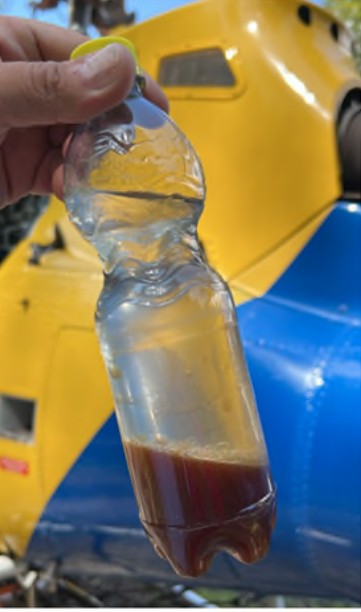
AS350B2 D-HEWU Fuel Sample (Credit: via BFU)
The tank was drained further until only clear fuel remained.
The bypass indicator of the airframe fuel filter did not trigger. After consultation with the [operator’s] CAMO [Continuing Airworthiness Management Organisation] the engine was restarted and the helicopter parked on a level surface, with the assistance of the company’s maintenance manager. After a waiting period, more contaminated fuel was drained, so it was decided to completely empty the tank.
Fuel was then delivered to the aircraft from “another vehicle”. There was a 190 litre uplift. After another pre-flight check, first a ground run, then a heavy hover, each lasting several minutes, were performed.
Since all parameters were normal, the pilot decided to continue the forest liming operation. [The] pilot positioned the helicopter above the bucket to pick up the load [of] c600 kg of lime. [When] the bucket was about 8 meters above the ground, the helicopter yawed, the main rotor speed decreased, and the low-rotor RPM warning sounded.
Operating Site (Credit: via BFU)
The pilot initiated an autorotation and headed for an area with flatter vegetation in
the forest.
The helicopter landed nose-down on the soft forest floor amongst young saplings. The pilot egressed unharmed. There was minor damage:
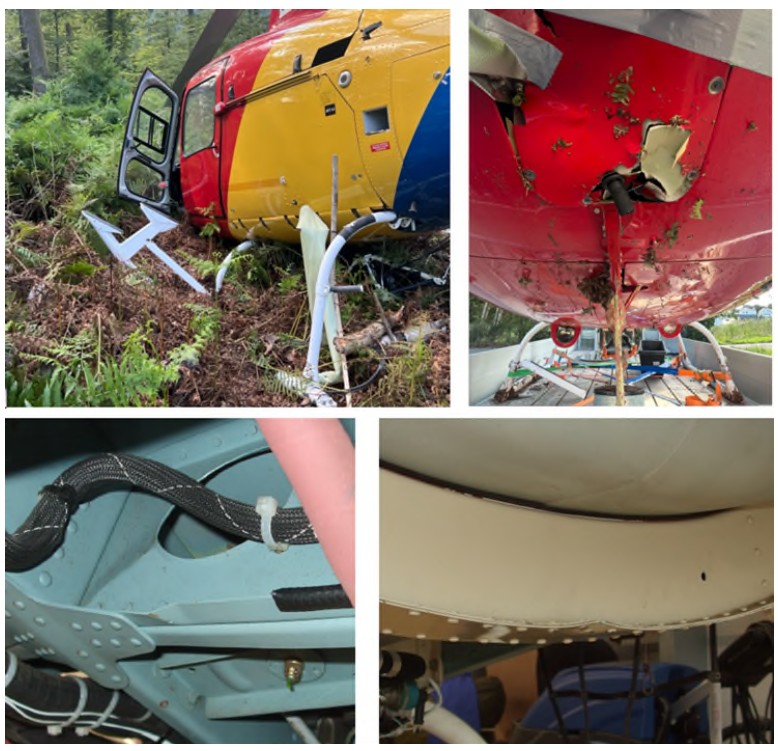
AS350B2 D-HEWU Damage (Credit: via BFU)
The Safety Investigation
Investigators opened the airframe and fuel control unit fuel filters.
The filter element of the airframe fuel filter was brownish in color, and brownish discoloration was found in the bowl. The functionality of both the mechanical and electrical blockage indicators of the airframe fuel filter were tested. Both functioned without issue.
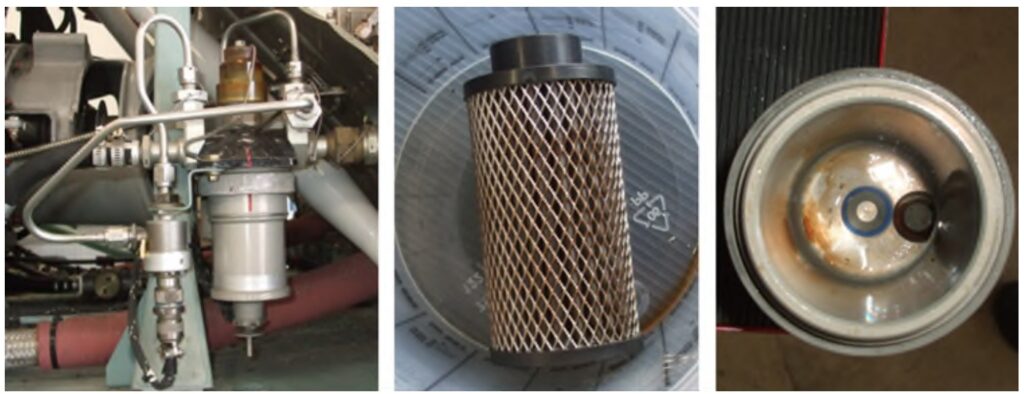
The FCU fuel filter was filled with fuel. The filter element showed numerous brown deposits on the outside, some of which were clumpy and jelly-like. After opening the filter, heavy soiling was found inside.
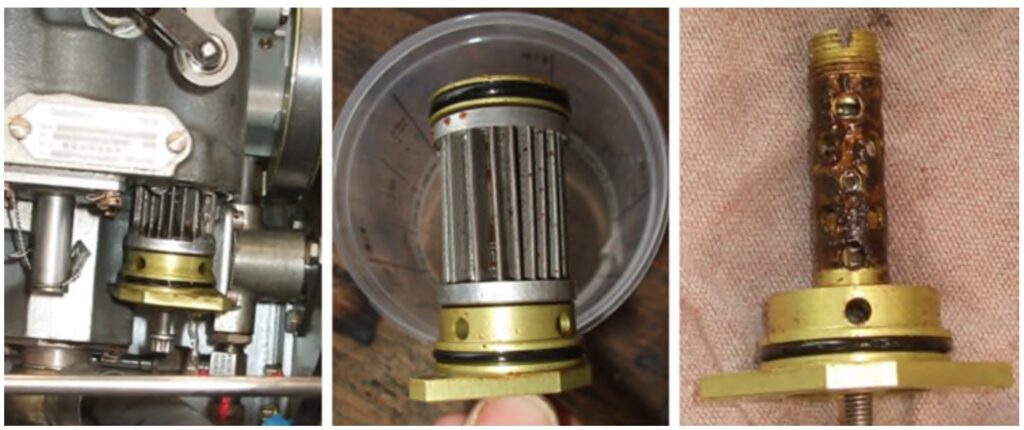
Laboratory analysis by the WIWeB army lab revealed that impurities, detected in all samples were a sodium acrylate/acrylic acid-based copolymer.
This plastic is a so-called superabsorbent polymer (SAP), capable of absorbing many times its own weight (up to 1,000 times its weight in polar liquids e.g., water). In doing so, it swells considerably and forms a gel-like substance. In combination with contaminants, this mass can eventually take on a viscous, sticky consistency. Upon drying, the substance becomes a brittle material that can be pulverized by mechanical action.

The WIWeB stated that:
The presence of the superabsorbent polymer in combination with water led to the formation of gel-like to viscous deposits on the fuel filters. Other components in the aircraft’s fuel system (e.g., the fuel pump) may also have been impaired by the foreign contaminant, potentially resulting in engine failure due to insufficient fuel supply. Because of the substance’s considerable water absorption capacity, even small quantities can cause significant system malfunctions.
SAPs are used, among other things, in water absorber kits in diesel fuel storage or transport tanks that lack a low-point drainage system. Aircraft turbine fuel systems should be designed …to be equipped with systems for separating water and solids. This can be either a water separator filter…or so-called filter monitors…which usually contain SAP for separating water.
Filter monitors carry the risk of SAP decomposition by other polar substances such as anti-icing additives or possibly cleaning agents. If the SAP then enters the aircraft systems during refueling, it can lead to massive blockages in the fuel system, especially the fuel filter.
The source of the SAP cannot be identified here, but it must be located within the
aircraft’s refueling chain. This chain should be checked with regard to the filtration
and drainage systems used.In addition, a heavy microbiological infestation with fungi was detected. This is not the cause of the observed blockage of the fuel filters, as no unusual amounts of biomass were found. However, microbiological infestation, especially with fungi, can lead to the formation of biomass in the future and thus to blockages in the system. Furthermore, the partially acidic metabolic products of the microorganisms are corrosive and can cause damage to metallic components.
Following the incident, the fuel filter and water separator of the Ford Transit bowser were
checked and contamination was found in both. This vehicle had been refueled from a larger road bowser, that the company had recently purchased secondhand. According to lab reports this road bowser…
…showed massive contamination with water, biomass, and SAP. The used PIUSI CF 100 filter exhibited extensive rust deposits. The used CFD 150-30 water separator was severely damaged; the structure of the filter material was barely recognizable. The inner and outer paper filter layers were extensively torn, and the internal SAP material was present only in fragments. The tenacious, sticky deposits in the filter consisted of biomass and SAP.
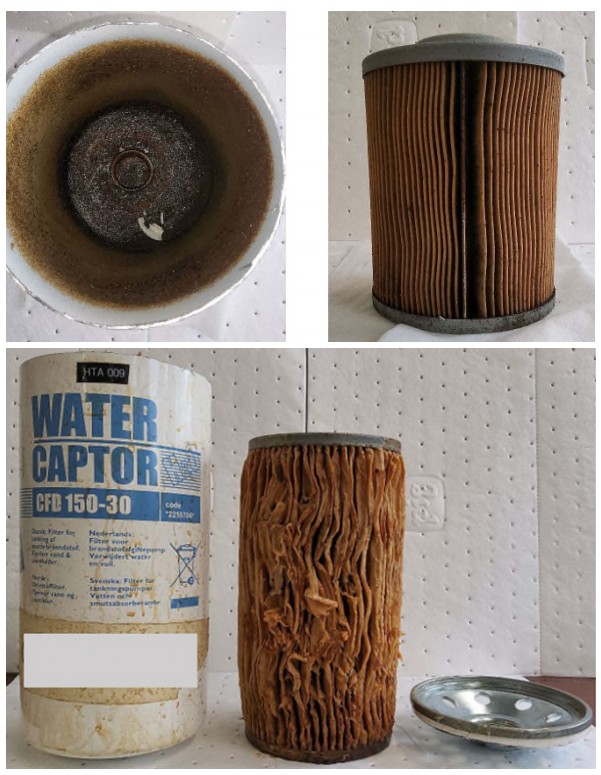
The BFU note that:
The company’s internal investigation revealed that the individuals involved were unaware of the potential hazards of SAP within the refueling chain, that no training or procedures existed regarding the drainage of mobile tankers, and that the filters and water separators used were replaced as needed. This replacement was not documented, and therefore the age of the filters and water separators was unknown.
Investigators comment that:
International Air Transport Association (IATA) published a 278-page report on the Investigation of Super Absorbent Polymer (SAP) Migration in Commercial Aviation Turbine Fuels.
Furthermore:
The European Union Aviation Safety Agency (EASA) published Safety Information Bulletin 2018-10R1 on Super Absorbent Polymers Contamination of Jet Fuel on 28 October 2020.
Airbus issued Information Notice No. 2145-I-28 regarding Fuel Quality in 2010. Revision 5 was published in 2022.
BFU Analysis
They “suspect” a partial engine power loss occurred due to the fuel contamination, while at high power to lift the load.
The investigation revealed that the procedures and responsibilities for ensuring fuel quality when using tanker trucks and mobile refueling systems were not adequately documented.
There was no training regarding the draining of the tank trucks, nor regarding the inspection and replacement of the fuel filters and water separators used. Therefore, there was no documentation of the fuel quality from the moment the tank truck was refueled at the filling station at the company headquarters, nor about the replacement or age of the filters and water separators and their usage (e.g., total flow rate).
The investigators noted that:
On the day of the incident, even before the engine power loss that led to the emergency landing in the forest, the engine exhibited noticeable performance deficiencies under high load.
The measures taken on-site in the forest after consultation with the CAMO and the company’s Maintenance Manager (draining, final refueling, refueling, ground run) were comprehensible and corresponded to standard procedures when significant amounts of water or dirt are detected in the fuel during a pre-flight check.
However:
During the troubleshooting of the engine power loss, the airframe fuel filter and the fuel
control unit (FCU) filter were not checked.An inspection would have revealed contamination of the entire fuel system. Apparently, the maintenance personnel relied on both the unactivated mechanical and electrical blockage indicators of the airframe fuel filter.
The BFU’s investigation identified the presence of SAP contamination.
This polymer could swell upon contact with water, forming a jelly-like substance and thus clogging the fuel filters or at least impeding fuel flow.
Contrary to the initial assumption that the tanker truck [i.e. the larger secondhand road bowser] used for the first time was the primary cause, investigations of the fuel samples and the fuel filters and water separators used in the refueling chain revealed that the mobile refueling system in the tanker truck was the main source of the fuel contamination, and the water separator used at the refueling station was the source of the SAP.
The tanker truck was likely the source of the water in the fuel as a result of the cleaning of its tank compartments six days prior to being filled with fuel from the company’s own filling station [i.e. fixed fuel installation].
The investigators comment:
Fuel supply problems due to SAP contamination resulting from defective water separators are known in aviation. Several organizations and Authorities have already addressed this issue and published relevant guidelines and documents. SAP-based water separators should no longer be used in aviation, but they are not prohibited.
The investigation revealed that the potential dangers of SAP contamination in aviation fuels were unknown to the individuals involved.
BFU Conclusions
The serious incident, the emergency landing in the forest after a loss of engine power, occurred as a result of a disruption in the fuel supply due to contamination with a superabsorbent polymer.
The causes were a lack of staff training and insufficient procedures to ensure fuel quality during mobile refueling, as well as the use of unsuitable filters and water separators on the mobile refueling system within the refueling chain.
Operator Safety Actions
- Their fuel supplier “conducted a training session, explaining how to check Jet A1 fuel for water and emphasizing the importance of density tests”.
- New fuel quality procedures were developed.
- The fuel bowsers were refurbished. Water and particle filters were replaced with SAP-free filters suitable for aviation fuels.
- The inspection of tank vehicles is now under the supervision of the Nominated Person Ground Operation (NPGO). The data was recorded in Flightlogger software.
Due to these actions the BFU choose not to make any safety investigations.
Safety Resources
The European Safety Promotion Network Rotorcraft (ESPN-R) has a helicopter safety discussion group on LinkedIn. You may also find these Aerossurance articles of interest:
- Cold Comfort Conference Call: USAF F-35A Alaska Accident
- Turbine Dromader M18A Downed by Fuel Contamination: Shell Detector Capsules Misused
- The Wrong Fuel: Three Misfuelling Accidents
- Helideck Safety Alerts: Refuelling Hoses and Obstructions
- HESLO R44 Snagged by its Own Longline
- Poor Contracting Practices and a Canadian Helicopter HESLO Accident
- Snagged Sling Line Pulled into Main Rotor During HESLO Shutdown
- Garbage Pilot Becomes Electric Hooker
- Load Lost Due to Misrigged Under Slung Load Control Cable
- Keep Your Eyes on the Hook! Underslung External Load Safety
- Impatience Comes Before a Fatal Fall During HESLO
- Fatal Fall after HESLO Helicopter Hooks Worker
- Inadvertent Entry into IMC During Mountaintop HESLO
- HESLO AS350B2 Dropped Load – Phase Out of Spring-Loaded Keepers for Keeperless Hooks
- Unballasted Sling Stings Speedy Squirrel (HESLO in France)
- Dynamic Rollover During HESLO at Gusty Mountain Site
- Fuel Starvation During Powerline HESLO
- HESLO Baffled Attitude Fuel Starvation Accident (Haverfield Aviation Hughes 369E N765KV)
- UH-1H Fuel Exhaustion Accident
- The Curious Case of the Missing Shear Pin that Didn’t Shear: A Fatal Powerline Stringing Accident
- HESLO Dynamic Rollover in Alaska
- Shocking Accident: Two Workers Electrocuted During HESLO
- HESLO EC135 LOC-I & Water Impact: Hook Confusion after Personnel Change
- HESLO AS350 Fatal Accident Positioning with an Unloaded Long Line
- A Concrete Case of Commercial Pressure: Fatal Swiss HESLO Accident
Airbus issued Safety Information Note (SIN) No 3170-S-00 on 3 October 2017.
See: UK CAA‘s CAP 426: Helicopter External Load Operations too.

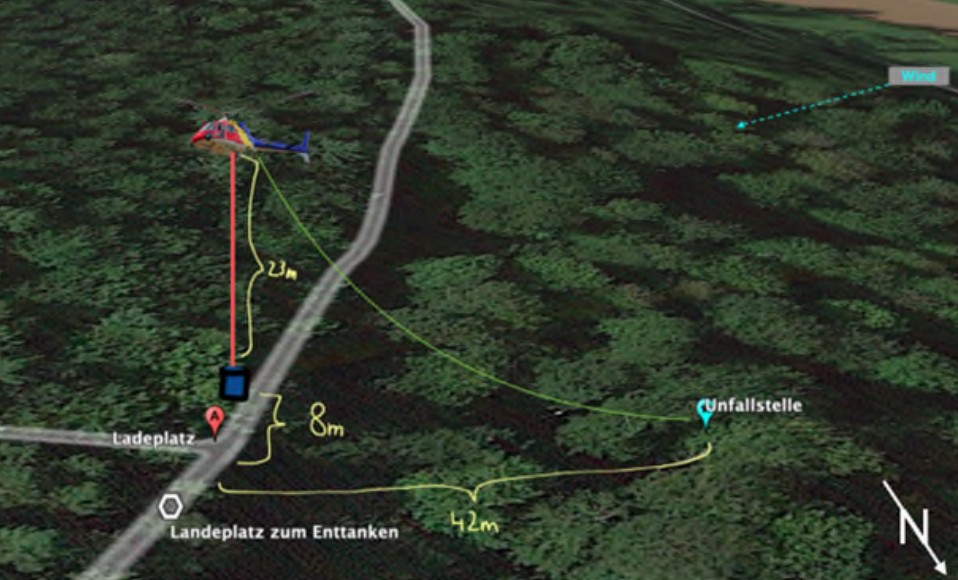
Recent Comments